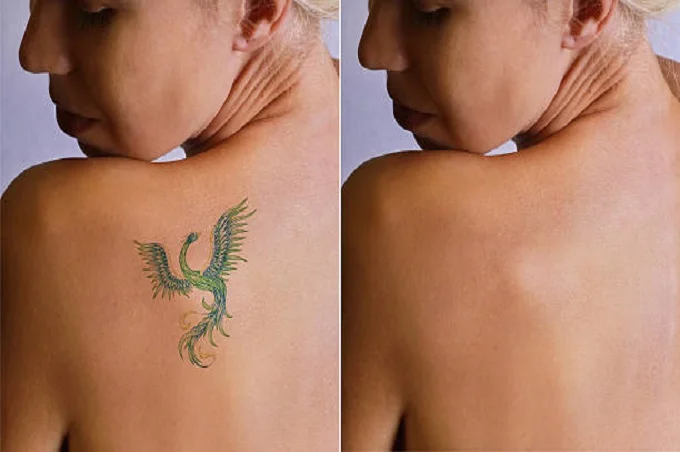Adolescence is a period in life when drawings on the skin are stuffed most often. And then unearthly love passes; with age, a person sometimes noticeably gets fatter, the image begins to irritate or even interfere with a business or other professional career. And then the search begins for a salon where the mistakes of youth could be reduced.
Therefore, the question of how long after applying the tattoo can be removed does not make sense as long as it takes until the circumstances change. As a rule, this is about ten years old – by the age of thirty, the vision of life changes a lot. Tattoo removal has always been a difficult task, but now many methods are available.
7 best tattoo removal methods
1. Laser tattoo removal
The most famous and popular method today. It is really possible to remove a tattoo with a laser, and it is even safer, more comfortable, and more effective than most other methods. It provides a complete image reduction, but you need to go through an average of five to seven sessions for this.
Between them, it should be maintained for about a month so that the skin has time to recover. In one session, you can burn an area of no more than 15-20 cm2 with a laser. Therefore, large drawings must be reduced in parts.
2. Chemical methods
Based on the destruction of pigments by chemicals. The most common reagent is phenol. Naturally, it is aggressive, causes burns, can cause poisoning, and harm internal organs, primarily kidneys and liver. The remover is less aggressive – the liquid used in manicure, but it allows you to reduce tattooing and permanent makeup, and they will not be able to remove a full-fledged tattoo. Home remedies like iodine or potassium permanganate are useless and dangerous burns.
3. Surgical tattoo removal
Historically, this is the first way of information when others were technologically impossible. Roughly speaking, the upper layers of the skin area with the pattern are cut off. If the pigments have penetrated shallow and the image is small, the skin will recover by itself; the first few weeks will need care and a bandage.
In other cases, skin grafting from different body parts will be required. The method is suitable for removing tattoos no more than 7 cm in length and 1 cm in width. Otherwise, it will be long and hard to heal.
4. Mechanical peeling or dermabrasion
The drawing is simply erased from the skin, like an eraser. To do this, use a milling tool with a coating of diamond chips. Stone dust provides an abrasive effect, so this method is also called dermabrasion. The main limitation is that the skin should be completely healthy. The method is suitable for tattoo removal if the pigments have penetrated into the thickness of the skin no deeper than 1.5 mm. The cutter also captures up to 5 mm of clean skin around the pattern.
5. Cryodestruction of tattoos
Ten years ago, this method was very popular. The skin area with the pattern was treated with liquid nitrogen, the temperature of which is -195.8 ° C. Due to the cryogenic shock caused by the ice burn, the pigments were destroyed.
However, the skin suffered along with it and then healed for several weeks or even months, often covered with scars and scars. And although the method gave a quick removal of tattoos, the described side effects significantly reduced its popularity.
6. Removal by coagulation
The method has two varieties: electric and cold plasma. The first one is much cheaper and therefore more well-known—an electric current burns out the drawing along the contours. Of course, its strength and tension are minimal there, but a dry skin bubble remains in the place of the information. It soon falls off, exposing thin scars that may never heal. The second option is more accurate but has many disadvantages, and besides – cold plasma is very expensive.
7. Overlapping another tattoo
A rather peculiar method of tattoo removal. We are not talking about information, but only about lighting to make room for a new drawing. To do this, chemicals are used that are less aggressive and safer than phenol, for example, strong concentrated organic acids: acetic, formic and others, alcohols, etc. In some cases, even clarification is not required if the old image can become the basis of a sketch for a new one and organically fit into it.
Is tattoo removal painful?
Yes, it is painful with any method used to choose. The difference is only in the degree of discomfort. Whatever method you use, you still have to remove the top layer of skin and touch even the main one. Of course, this causes unpleasant sensations; there is a risk of inflammation. Therefore, you need to think carefully before you fill some kind of pattern on the skin and before you go to the salon to reduce it.
Is it possible to remove the tattoo completely?
The effectiveness varies greatly from method to method. The surgical method will give one hundred percent result simply because the skin with the pattern will be cut off. The laser method requires several sessions; if you stop halfway, the tattoo will be pale, partially erased, but quite noticeable. In addition, much depends on the characteristics of your skin and the quality of the pigments with which the image was applied.
Contraindications for tattoo removal
For the first four weeks after applying the tattoo, it is not worth removing it – the skin is already injured, there is no need to torment it again. Wait a while if you have a chronic illness that has worsened, picked up an infection, recently tanned, or injured in the drawing area. Pregnancy, breastfeeding, oncology, skin diseases, diseased vessels, or severe diabetes also exclude tattoo removal by any method.
